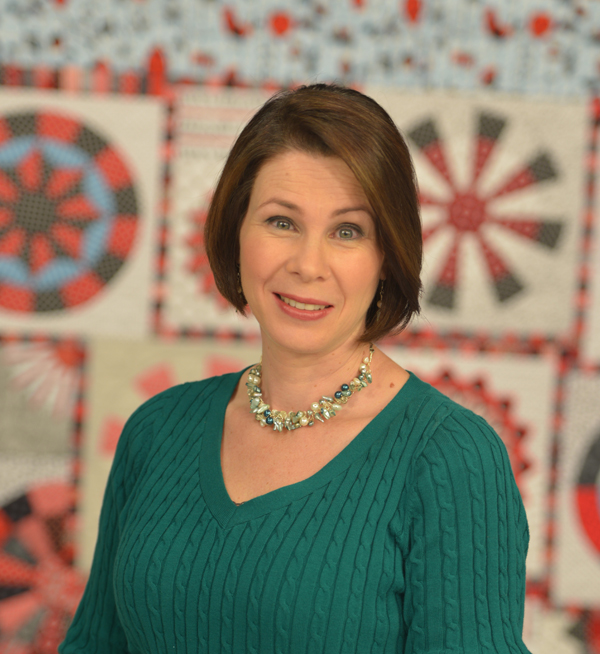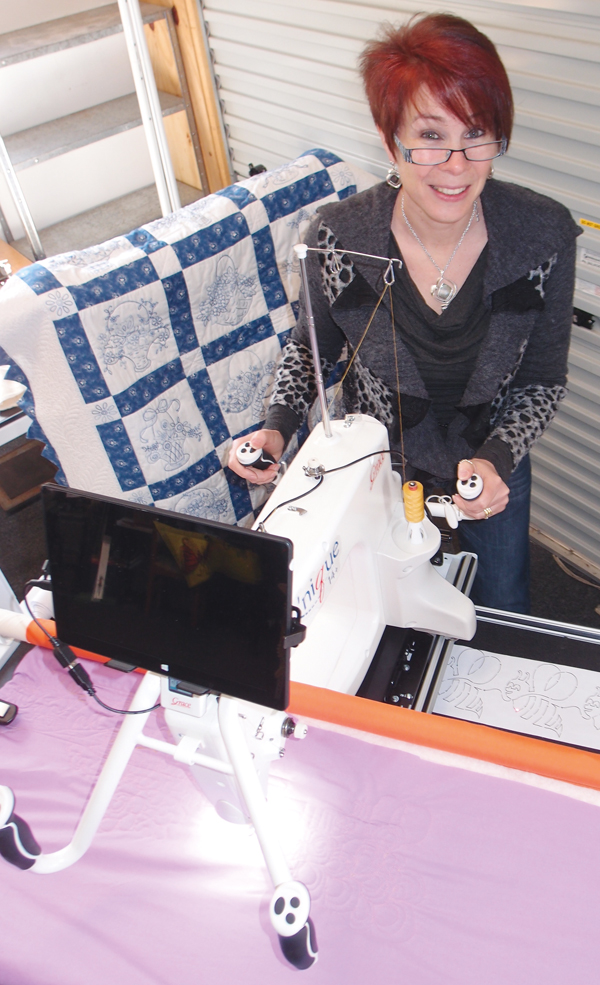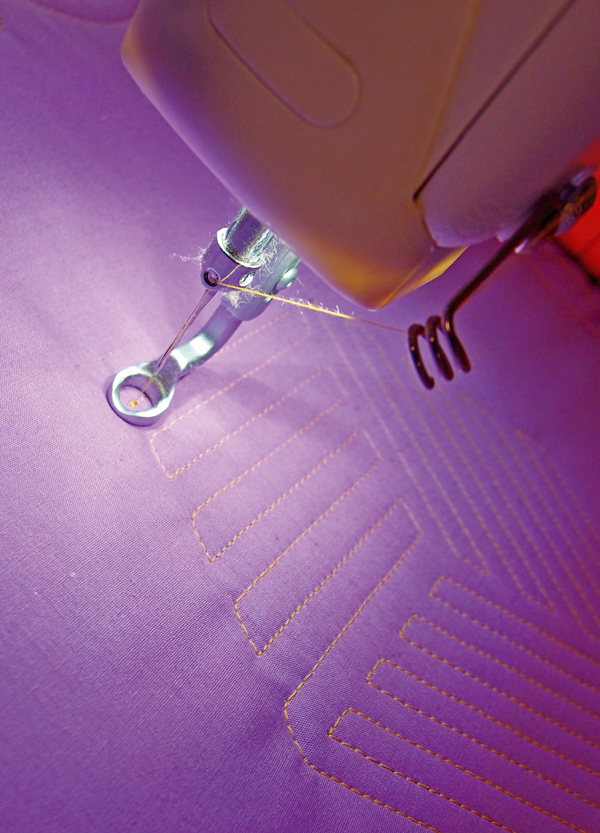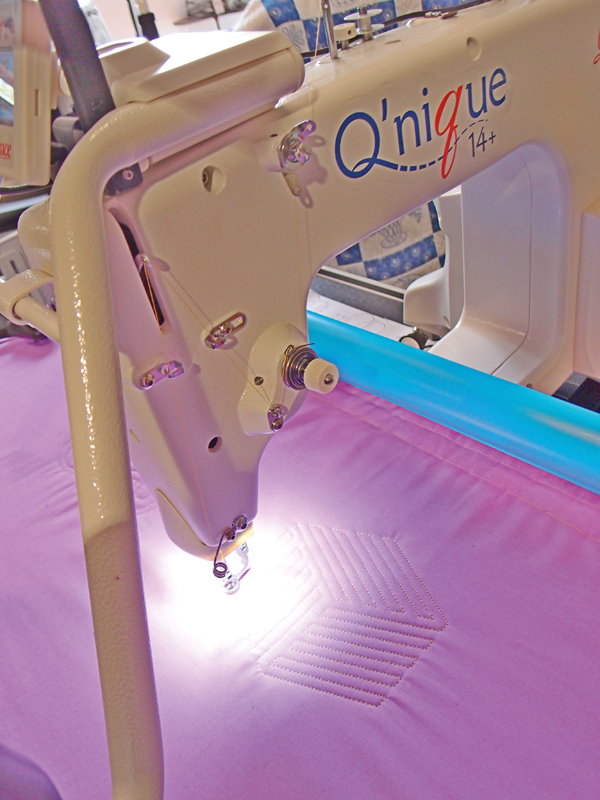
Q’nique 14+ Mid-arm Quilting Machine Driven By Michelle Marvig
Constructing the quilt top is only half of our journey towards completing a quilt. The quilting of the three layers is integral to the finished look of the project. Big quilts can be hard to handle on a domestic machine and bigger machines can make this job easier. I recently played on the Q’nique 14+ quilting machine, a new mid-arm quilting machine from The Grace Company.
This machine lies between a domestic sewing machine and a long-arm machine for available sewing space. Like a long-arm machine, the Q’nique sits on a large frame and the quilt top and backing is loaded on rollers. The machine moves over the quilt, rather than you moving the quilt under the needle. But it’s like buying a car: there are so many options to consider.

Make this charming cushion with appliqué forest mushrooms!
If you have not looked into buying a long- or mid-arm machine before, it can be daunting. The machine head is sold as a stand-alone item, but requires a frame to support it. The Q’nique will fit a variety of frames and, if you already have a frame, it’s best to confirm that yours is compatible.
The machine has a dual wheel system on a 45-degree angle, which runs on the track of the frame. It was very stable and easy to move. However, I did spend time on a machine with the computer automation attached, and the extra belts did make it slightly heavier to move.

Standard inclusions with the basic machine are the comfort grip; front handles (where the control buttons are located); full-colour OLED-screen showcasing modes; built-in stitch regulation; capability of stitching 1800 stitches per minute; four quilting modes; over-speed warning, independent automatic bobbin winder; M class bobbin; LED lights over the needle; dual thread cones; and additional ports for accessories.
Optional extras are many and include a laser stylus for use with pantographs; rear handles for working from the back of the machine; a ruler base, which is a flat extension table placed around the needle area to support the use of rulers; Quilt Motion (the hardware) and Quilters Creative Touch (the software) for automated quilting; and a foot control, if you want to turn the machine into a sit-down, free-motion machine.
But getting down to the nitty gritty, how easy is it to use? Answer … very! Threading was basic, following the instruction book. Unlike a domestic machine, everything is on the outside and easily seen.
The bobbin case loads from the front and clicks into position. Thread tension is adjusted by turning a dial on the right of the machine. I first worked from the front of the machine, over the quilt, doing freehand quilting. In Precise and Cruise mode you choose between four and 16 stitches per inch.
When in Precise mode, the machine stops stitching when you stop moving; in Cruise mode, the machine will keep stitching until you hit the off button. In Manual mode, you have control over the speed of the machine and your movement will determine the stitch length — great for tiny stippling or fills.

Ma Bunny Pincushion is a sweet little project and the perfect sewing accessory!
And I found I loved the Baste mode. You can choose three different lengths of basting stitch and the machine will rapid fire the needle into the quilt at even intervals, without any drag, as you go across the quilt. Basting can be used, for example, to secure the edges of the three layers together before the main quilting begins or to prepare the layers of a quilt for hand quilting.
All modes are displayed on the OLED screen and changes are made through the buttons on the handles. The Q’nique is listed as 14+, which is the size of the throat space of the machine. It is actually 15in from the back of the hopping foot to the body of the machine. However, the upper roller and the shape of the hopping foot take up some of this space, and the true quilting area for the machine is about 10in–11in.
The Grace Company also manufactures machine quilting frames. The size of the frame that you choose will determine the largest possible size of quilt that can be stitched. All frames have adjustable heights. Standard frames have three rollers, with an optional extra being a fourth roller for storing batting.
The quilt top and backing are loaded on the rollers. To do this requires leaders – lengths of heavy fabric with a pocket that slips on the rollers. The backing fabric and quilt top are then pinned or zipped to these leaders to create an even tension on the fabrics from the top and bottom of the quilt.

Start-Right Quilt Clips are another optional extra. They are plastic sleeves that are simply slipped over the quilt top and batting on the front roller to tension, removing the need to attach the quilt top to the leader. They are available to fit 1½in or 2in rails.
To tension the sides you can use Bungee Clamps — these are slightly rounded, spring-loaded clamps on a length of heavy elastic. They are attached to the edge of the quilt and pulled back through an opening on the frame, easily pulling down to lock into place.
An extra plastic ball can be manually slid up to behind the opening for extra security, just like you might find on a winter parker. The rollers have a plastic ratchet system on the end, which you tension against when everything is in place.
And then there is the Quilt Motion, which is the hardware required to set up the machine for computerised quilting. It works in conjunction with the Quilter’s Creative Touch software program for computer-generated quilting.
This program works on any Windows 8 or higher tablet. I could have played all day! You can tell the computer the size of the quilt, how many repeats you want, how high and it will work it all out for you and display it on screen before you start. Or, if you wish to place a block design on a quilt, but the block is not square, you can show the machine the shape of the block by moving the machine head and needle, and the computer will resize the pattern to fit the block.
You can freehand a design and the program will save and replicate it for you. It comes with more than 200 in-built designs, but extra patterns can be purchased and imported into the program. The machine ties off at the beginning and end of each automated quilting design. I really did not want to stop playing with this fabulous software and I am sure it does more than I have mentioned here.
All Grace Company products are brought into Australia by Know-How Sewing Essentials. They have a team of eight qualified installers in Australia and New Zealand. When you purchase through this company, the machine and frame are delivered and set up so that you’re ready to quilt when they leave — you’re not just purchasing a big box.
They also offer a discount on your quilting supplies if you purchase a machine through them. If you don’t catch up with them at one of the quilt shows, their website is www.qniquequilter.com.au or you can email them at mail@knowhowsewing.com.au


